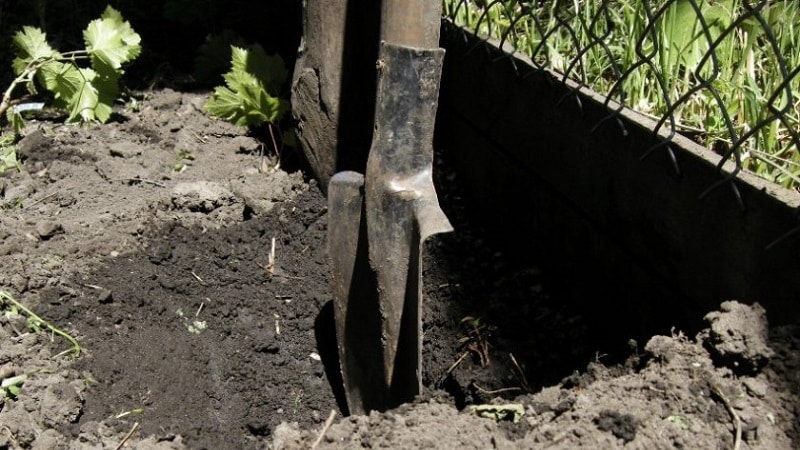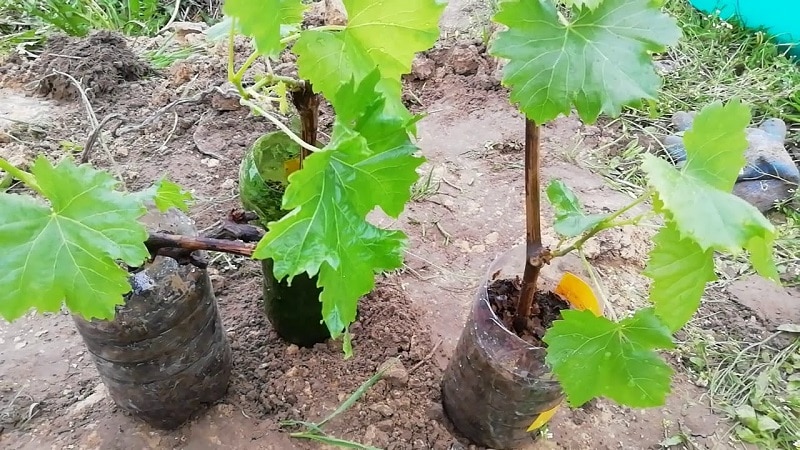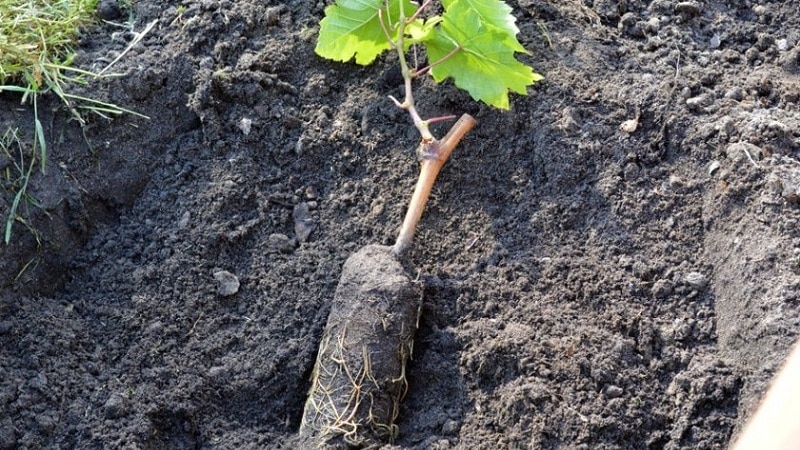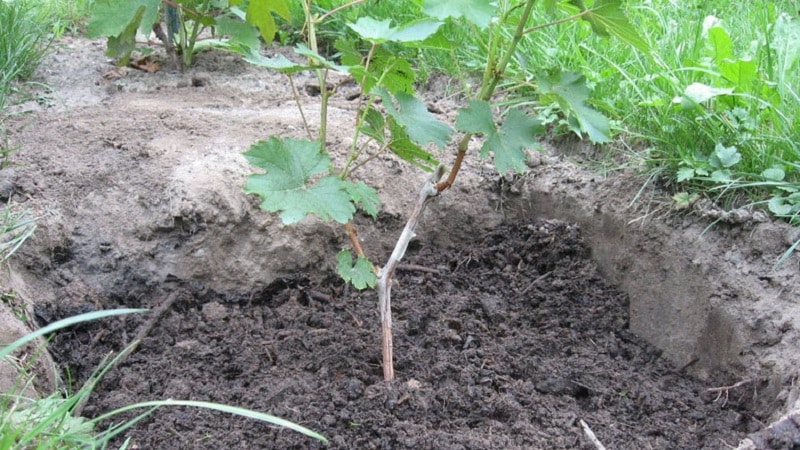How to properly plant grapes in spring in open ground
Many novice summer residents are afraid to plant grapes on their plot. And in vain: landing and growing delicious berries will not cause any trouble if you follow the detailed step-by-step guide. The grape takes root in the Moscow region and Krasnodar region, the Volga region and Tatarstan, the Urals and Siberia.
How to plant a grapevine correctly and what recommendations to follow when planting seedlings and cuttings, we will consider in the article.
Planting grapes in spring
Grapes are planted both by cuttings and seedlings. After planting in the spring, the pace of development accelerates. The heat-loving plant gains strength over the summer, strengthens its immune system and prepares for winter. That is why spring planting is preferable to autumn planting, when the first frosts immediately set in and snow falls. Most grape varieties do not tolerate cold weather.
The disadvantage of spring planting is that after winter insect pests wake up, pathogens, so the young plant needs careful care. Summer residents carry out preventive and protective measures, spraying grapes with chemicals and folk remedies. For spring planting, seedlings are purchased in the fall and keep them all winter in the basement. During this time, they may become weak or get sick.

When to plant grapes in spring
Cuttings and seedlings with a closed root system are planted in late spring - early summer, with open - already at the end of April or beginning of May.When choosing a date, it is important to pay attention to weather conditions and temperature. If it is raining outside or strong winds are blowing, the air temperature does not rise above +5°C, planting is postponed. The air should warm up to +15°C, and the ground - to +10°C.
Favorable days according to the lunar calendar
Using the lunar calendar, gardeners choose the days when planting grapes in open ground will be more successful. It is generally accepted that if you plant a plant on certain dates, it will get sick less and bear fruit better.
The choice of date depends on the rising and waning moon. In 2020, April 30 or May 29 are chosen for planting grapes. Unsuitable dates: May 7, 8, 12, 13, 20, 21.
Attention! Even if the lunar calendar says that April 30 and May 29 are suitable for planting, it is important to pay attention to weather conditions. Air and soil temperatures are the main criteria when choosing a period.
Choosing a landing site
Grapes do not tolerate shade, so the plant is planted in the sunniest and well-lit places. There should be no tall buildings, fences or other structures nearby, otherwise they will block the sun. It is also important to exclude the presence of roads near the bush, as dust will settle on the fruits. It is recommended to place the plant in windless and dry places, away from groundwater. If the garden has a sunny hilly area, then the grapes are placed on it.
The soil must be loose and nutritious, otherwise the plant will not develop well.. A suitable option is crumbly chernozem and purchased soil mixed with sand, rotted organic matter, and mineral components. Sandy or clayey soils are not suitable. They do not retain moisture and do not allow air to pass through well.Soil acidity should be moderate - from 4 to 8 pH. Excessive acidity leads to the death of the plant.
Preparation of planting material
Grapes are planted by cuttings, seedlings or vines. Cuttings are prepared in February or March. They are inspected, dry and damaged specimens are thrown away. To check the viability of the cutting, it is squeezed - moisture appears on healthy stems. The cut has a greenish tint. The remaining cuttings are soaked in water for 2 days, then placed in growth stimulants for a day: “Athlet”, “Krezacin” or “Kornevin”. They strengthen the plant’s immunity, increase its cold resistance, and improve the taste of future fruits.

When choosing seedlings, pay attention to the roots. There should be at least 4 of them - the more, the better the root system develops. A healthy seedling has large, long and elastic roots. The cut should be moist and white. Thin seedlings with dry and limp roots are not suitable for growing. This indicates that the plant is sick and will die after planting in open ground. The recommended length of a seedling is 30-40 cm. Sometimes 2- or 3-year-old seedlings already have 1-2 vines. If they are large, they will quickly take root and immediately produce several healthy shoots. The diameter of the vine must be at least 3 mm.
If a vine is immediately used for planting, it is treated 3% solution of iron sulfate. For preparation, 1 liter of water and 30 g of substance are required. The vine should not be too long, as the risk of infection by microbes and fungi increases. It is recommended to pay attention to its elasticity and the absence of cracks and stains.
Soil preparation
The soil for spring planting is prepared in the fall. In a southern and sunny place, dig a planting hole 80 cm deep and 70-90 cm in diameter. To make the soil breathable, a 10 cm drainage layer of broken brick or stone is laid at the bottom of the hole. Before winter the pit is fertilized with a nutrient mixture - 1 kg of dry wood ash, 800 g of superphosphate, 1 kg of humus. Then water generously with warm water. In the spring, before planting, the soil is dug up to 60-80 cm.
Attention! If summer residents do not have time to prepare a hole in the fall, then in the spring they dig trenches measuring 65x65 cm for the grapes. This is done 4-8 weeks before planting. The bottom of the pit is made drainage, and the soil is fertilized with rotted manure or compost.
How to plant grapes in spring - step-by-step instructions
The landing procedure will not take much time, the main thing is - choose calm and cloudy weather and prepare planting material.
How to plant grape seedlings in spring step by step:
- Insert a plastic tube with a diameter of about 5 cm into the hole on the side - it will later be used to water the plant.
- Add soil to the hole so that 50 cm remains to the top. Summer residents use garden or ready-made store-bought soil “Universal” or “Krepysh”. It contains vitamins and minerals for plants and is disinfected in advance.
- Water the pit with settled water heated in the sun. Wait until it is completely absorbed.
- Remove the grapes from the pot or container. Carefully straighten the roots of the seedling and place it in the hole. Cover it to the brim with dry soil.
Planting with cuttings is similar to planting with seedlings. It is only important to pay attention to the location of the cuttings - they are placed at an angle, vertically or in an arc.

Planting scheme, what to plant nearby
When determining a planting scheme, gardeners pay attention to the variety, plant height, vine size. A distance of about 2 m is maintained between medium- and low-growing bushes, and 3 m between tall bushes. The width of row spacing is from 1.5 to 2 m. Grape bushes should not be planted too close to each other - in this case, the plant creates a shadow and prevents the growing plant next to it from developing bush. Also, when the planting is dense, the grapes are poorly ventilated, which has a bad effect on the taste and appearance of the fruit. The bushes are located from north to south.
It is recommended to plant next to grapes carrots, sorrel, peas, beans, strawberries, cucumbers. Unsuitable neighbors for the crop are parsley, gooseberries, potatoes, celery. It is also not recommended to plant grapes next to tall apple and pear trees - fruit trees shade the grapes, and they suffer from a lack of sunlight. Fruit trees can “steal” grape nutrients from the soil.
Nuances of planting depending on the growing region
In the middle zone and northern regions, summer residents resort to tricks: on the north side of the bed, a screen of boards is installed along the entire length and painted green. The height of the structure is from 80 to 100 cm. The screen does not allow cold wind to pass through, which is especially important in the Urals, Siberia, and the middle zone. It heats up and creates favorable growing conditions. The seedlings are placed at a distance of 40 cm. Such a screen is indispensable in cool summers.
Attention! To ensure that the soil in the root system area warms up faster, the ground under the seedlings is covered with black film. This will prevent weeds from appearing and protect the soil from drying out. Another proven method will help preserve heat - placing stones around the seedling. They heat up and transfer heat to the plant and soil.
Depending on the type of grape
There are table and industrial grapes. The first is suitable for fresh consumption, the second is suitable for processing and preparing wine, juice, and champagne.
U table varieties the appearance of the berries matters - color and size. Therefore, it is important before and after planting to pay attention to organic and mineral fertilizers, on which the development of fruits depends. Such grapes are sensitive to the lack of sun, so planting them in the shade is unacceptable. Also, after planting, the plant is sprayed with a solution of Bordeaux mixture so that insects and diseases do not affect the bunches.
In technical varieties, taste plays a more important role than appearance.. Technical grapes are smaller, the plants do not have dense foliage. When growing, follow the recommendations for the neighborhood and location of the bushes. Thickened planting will lead to a decrease in yield.

Further care
Grapes love water, but cannot tolerate too much of it.. Before watering the plant, check the soil moisture level. Dip your finger into the soil and see how deeply the soil has dried out. For irrigation, use a tube installed next to the seedling during planting, or place a garden hose under the bush.
For watering, choose the morning - the optimal time, the grapes have woken up and are ready to be hydrated. If watered during the day, then in cloudy weather. Otherwise, the sun will cause the moisture to evaporate before it has time to penetrate the soil. Once a week, instead of watering, sprinkling is used - the procedure activates the process of photosynthesis and removes dust from young leaves.
Attention! To prevent water from evaporating, the vineyard is mulched. Sawdust, purified river sand, leaves, and hay are used.Mulch slows down the development of weeds and protects against aphids, mole crickets, and sawflies.
In the first year of life, ready-made preparations are chosen for feeding, for example “Gumi-Plus” or “Biovit”. They contain nitrogen and potassium in the amount necessary for a young plant. Before and after fertilizing, the grapes are watered. No fertilizer is applied to dry soil. The next procedure is carried out no earlier than a month later.
Tips and tricks
To ensure that the grapes grow healthy and bear fruit consistently, they are sprayed after planting. wood ash solution - 3 tbsp. l. for 1 liter of water. The components are mixed and infused for a week. Afterwards, the vineyard is sprayed 1-2 times a month. The solution protects against diseases and pests, disinfects the plant, and replenishes the lack of vitamins and microelements.
In the first year, summer residents regularly inspect the bushes and remove the resulting stepsons. They also keep the beds clean: weeds and fallen leaves are regularly removed. This reduces the risk of developing diseases.
Mistakes to Avoid
If the grape shoots dry out or become covered with plaque, and the root system does not develop, it means mistakes were made:
- premature landing;
- purchasing seedlings from an unverified place;
- acidic clay soil;
- improper storage of seedlings;
- failure to maintain proximity to other plants;
- selection of the northern site;
- groundwater nearby;
- excess or lack of fertilizers.
Conclusion
For planting grapes, cuttings or seedlings are used. When purchasing, pay attention to the appearance of the planting material - there should be no cracks or scratches on it. Before planting, the plant is soaked in a growth stimulator - it activates metabolic processes and increases future productivity.
The hole for planting is prepared in the fall: a drainage layer is laid on the bottom and the soil is fertilized with rotted organic matter. This ensures proper development of the bush. Grapes are planted at an air temperature of +15°C. Some summer residents rely on the lunar calendar when choosing a date.